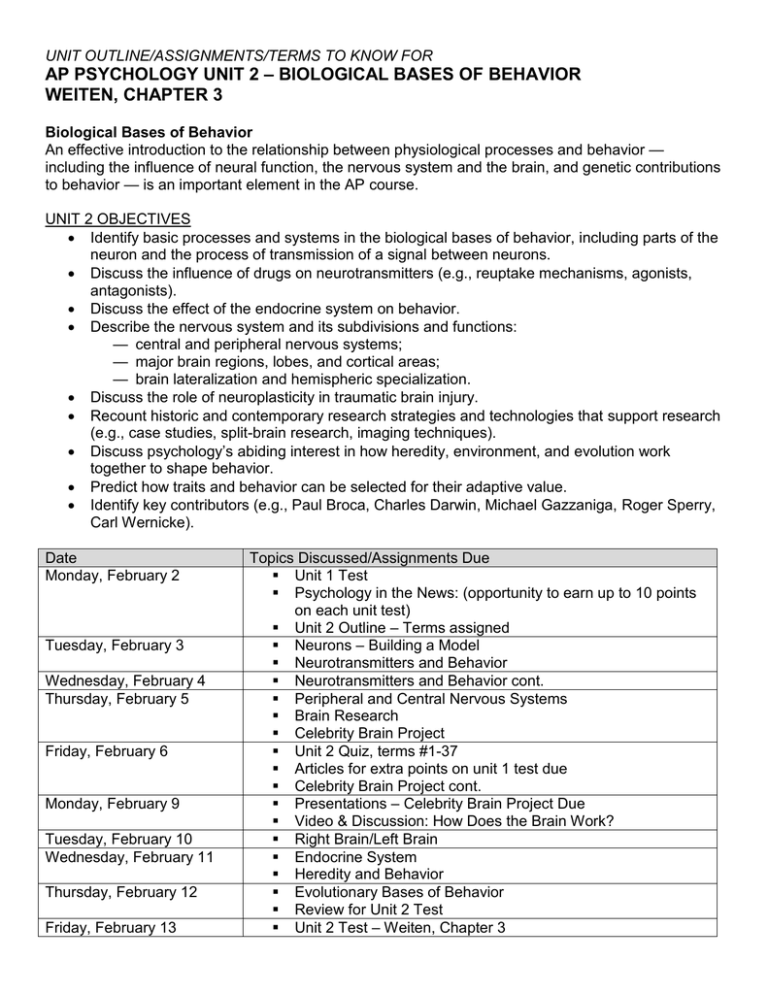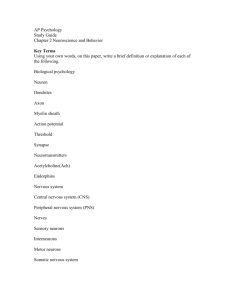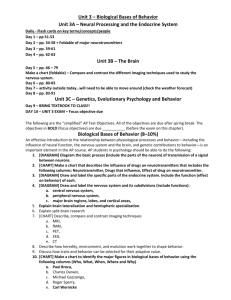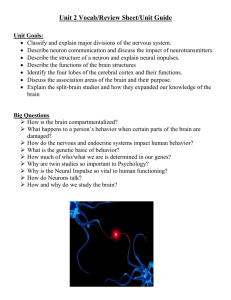AP Psychology Unit 2 – Biological bases of behavior Weiten, chapter 3
advertisement

UNIT OUTLINE/ASSIGNMENTS/TERMS TO KNOW FOR AP PSYCHOLOGY UNIT 2 – BIOLOGICAL BASES OF BEHAVIOR WEITEN, CHAPTER 3 Biological Bases of Behavior An effective introduction to the relationship between physiological processes and behavior — including the influence of neural function, the nervous system and the brain, and genetic contributions to behavior — is an important element in the AP course. UNIT 2 OBJECTIVES Identify basic processes and systems in the biological bases of behavior, including parts of the neuron and the process of transmission of a signal between neurons. Discuss the influence of drugs on neurotransmitters (e.g., reuptake mechanisms, agonists, antagonists). Discuss the effect of the endocrine system on behavior. Describe the nervous system and its subdivisions and functions: — central and peripheral nervous systems; — major brain regions, lobes, and cortical areas; — brain lateralization and hemispheric specialization. Discuss the role of neuroplasticity in traumatic brain injury. Recount historic and contemporary research strategies and technologies that support research (e.g., case studies, split-brain research, imaging techniques). Discuss psychology’s abiding interest in how heredity, environment, and evolution work together to shape behavior. Predict how traits and behavior can be selected for their adaptive value. Identify key contributors (e.g., Paul Broca, Charles Darwin, Michael Gazzaniga, Roger Sperry, Carl Wernicke). Date Monday, February 2 Tuesday, February 3 Wednesday, February 4 Thursday, February 5 Friday, February 6 Monday, February 9 Tuesday, February 10 Wednesday, February 11 Thursday, February 12 Friday, February 13 Topics Discussed/Assignments Due Unit 1 Test Psychology in the News: (opportunity to earn up to 10 points on each unit test) Unit 2 Outline – Terms assigned Neurons – Building a Model Neurotransmitters and Behavior Neurotransmitters and Behavior cont. Peripheral and Central Nervous Systems Brain Research Celebrity Brain Project Unit 2 Quiz, terms #1-37 Articles for extra points on unit 1 test due Celebrity Brain Project cont. Presentations – Celebrity Brain Project Due Video & Discussion: How Does the Brain Work? Right Brain/Left Brain Endocrine System Heredity and Behavior Evolutionary Bases of Behavior Review for Unit 2 Test Unit 2 Test – Weiten, Chapter 3 Unit 2 Terms to Know 1. Phrenology 2. Neurons 3. Dendrite 4. Axon 5. Myelin sheath 6. Glial cells 7. Action potential 8. Resting potential 9. Refractory period 10. Threshold 11. All-or-none response 12. Synapse 13. Neurotransmitters 14. Reuptake 15. Acetylcholine 16. Dopamine 17. Serotonin 18. Norepinephrine 19. Endorphins 20. Agonist 21. Antagonists 22. Central nervous system 23. Peripheral nervous system 24. Nerves 25. Sensory neurons 26. Motor neurons 27. Interneurons 28. Somatic nervous system 29. Autonomic nervous system 30. Sympathetic nervous system 31. Parasympathetic nervous system 32. Reflexes 33. Endocrine system 34. Hormones 35. Adrenal glands 36. Fight-or-flight response 37. Pituitary glands 38. Lesion 39. EEG 40. CT scan 41. PET scan 42. MRI 43. fMRI 44. brainstem 45. medulla 46. thalamus 47. reticular formation 48. cerebellum 49. limbic system 50. amygdala 51. hypothalamus 52. hippocampus 53. cerebral cortex 54. frontal lobes 55. parietal lobes 56. occipital lobes 57. temporal lobes 58. motor cortex 59. somatosensory cortex 60. Broca’s area 61. Wernicke’s area 62. Plasticity 63. Neurogenesis 64. Corpus callosum 65. Split brains 66. Cognitive neuroscience 67. Dual processing 68. Identical twins 69. Fraternal twins 70. Molecular genetics 71. Heritability







